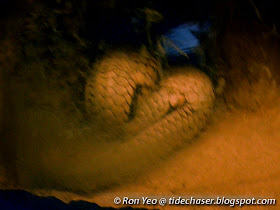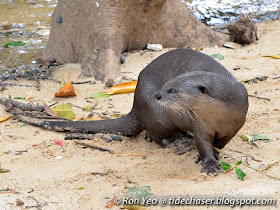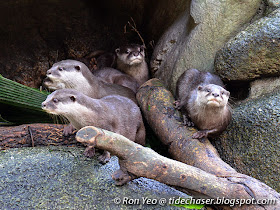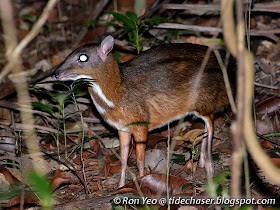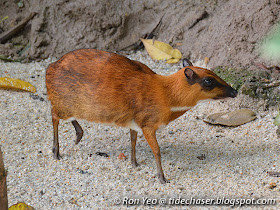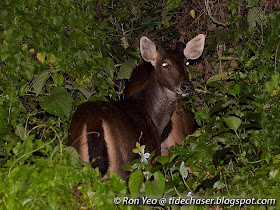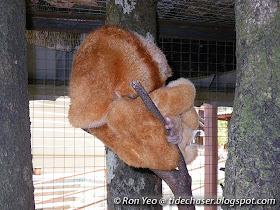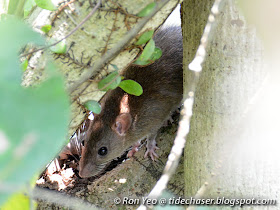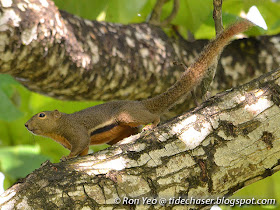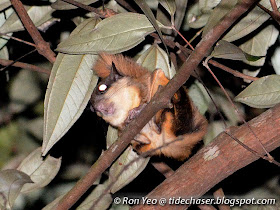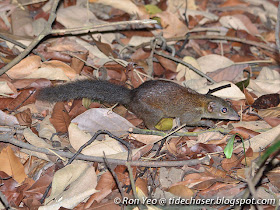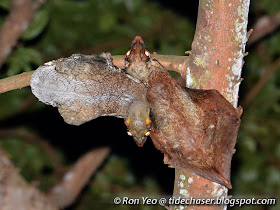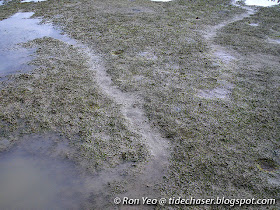"Limpet" is a common name for various groups of marine snails with flattened conical shells, and these different snails may not even be closely related. The term "true limpet" is used to describe members of the clade Patellogastropoda. It can get rather confusing trying to differentiate the various species of true limpets and false limpets, and hence I decided to create this page to list the snails with flattened conical shells that I had photographed in Singapore. I hope this will make it easier for readers of my blog to identify to the species or genus. You may want to take a look at my diagram on the parts of a snail's shell if you are not familiar with the names of the parts, so as to better understand the terms used below.
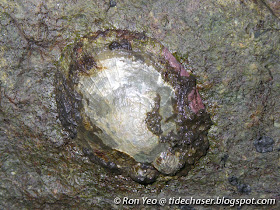
Rayed Wheel Limpet (Cellana radiata) - From the family Nacellidae, the Rayed Wheel Limpet is a true limpet. It has a mother-of-pearl iridescence on the interior of its shell, which can be seen sometimes on the exterior surface too on well-eroded shells. It also has folds on the mantle edges acting as secondary gill leaflets, and a long radula (tongue-like structure for feeding) several times longer than the shell. It is usually found on rocky shores, and like other limpets, it does not move much during low tide to avoid dehydration, and also, the rocks will be baking hot under the sun. During high tide, it will move around, grazing on algae on the rock surface. It can grow to about 4cm long.
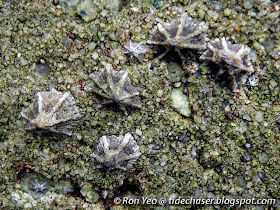
Sweet Limpet (Patelloida saccharina) - From the family Lottiidae, the Sweet Limpet is also a true limpet. Instead of breathing through secondary gills, it has feather-like gills, and the interior of its shell is porcellaneous. The shell is bilaterally symmetrical - very obvious with the prominent ridges (or ribs) on the shell exterior. Like the nacellids, they clamp tightly to the rocks during low tide, sealing the shell edges with the rock surface, protecting them from desiccation. This adaptation, together with their flattened conical shell also allows them to survive the strong waves pounding against the rock. It can reach length of about 2cm.

Javan Siphon Shell (Siphonaria javanica) - From the family Siphonariidae, the Javan Siphon Shell is not a true limpet, and hence the members of this family are often also called False Limpets. Unlike the true limpets that breathe with gills, siphonariids breathe with simple lungs. In addition, siphonariids are hermaphrodites, meaning each animal possesses both male and female reproductive systems, while true limpets have separate sexes. It is possible to differentiate some of the species by looking at the shells - the Sweet Limpet's shells are bilaterally symmetrical, if you look at the patterns and sculptures, but not the Javan Siphon Shell. It is about 1cm across.
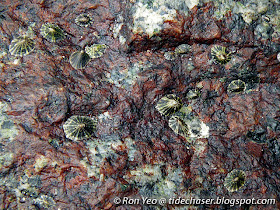
Guam Siphon Shell (Siphonaria guamensis) - Also from the family Siphonariidae, the Guam Siphon Shell has thinner and less protruding ribs, many of which are not continuous (with breaks in between). This is usually smaller, less than 1cm long.

Flattened Siphon Shell (Siphonaria atra) - Another member of the family Siphonariidae, the Flattened Siphon Shell is flatter and the ribs have the same colour as the background, and hence are less prominent. This species can reach length of about 2cm.

Singapore Keyhole Limpet (Diodora singaporensis) - From the family Fissurellidae, keyhole limpets have a hole at the top of the shell, and they are not true limpets as well. Instead of exposing their shells to the sun clinging to the rocks, they are usually found under rocks or in shady areas during low tide. Their flattened shells allows them to easily creep under rocks and into cracks and crevices to seek food and also to avoid the hot sun. The Singapore Keyhole Limpet is usually of a light brown, with darker bands radiating from the keyhole. The shell lacks the serrated or uneven edges found in many other keyhole limpets, and forms a nice oval shape at the base. It can grow to about 2cm long.

Chinese Shield Limpet (Scutus sinensis) - Also from the family Fissurellidae, shield limpets are usually found under rocks as well, usually with their mantle extending out of the shell and covering part of the shell. The Chinese Shield Limpet's mantle is brownish with darker blotches. It can grow to about 4cm long.

Nail Shield Limpet (Scutus unguis) - Another member of the family Fissurellidae, the Nail Shield Limpet has a black mantle which can cover the entire shell, hence it is sometimes mistaken for a slug. It can reach a length of about 4cm.
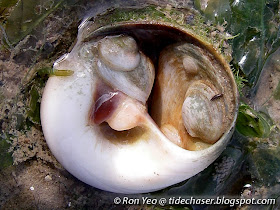
Walsh's Slipper Limpets (Siphopatella walshi) - From the family Calyptraeidae, the Walsh's Slipper Limpet appears like one side of a clam shell. It is a snail though, with a single white shell. Instead of attaching to rocks like the other limpets above, Calyptraeids attach themselves to shells occupied by hermit crabs or to the undersides of horseshoe crabs. They are filter feeders, and hence living with the hermit crabs means opportunities of food particles sent to the water column as the hermit crabs feed. The bigger females can grow to about 3cm acaross.
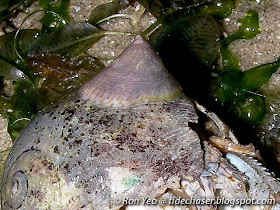
Cup-and-Saucer Limpet (Calyptraea extinctorium) - Also from the family Calyptraeidae, the Cup-and-Saucer Limpet attach itself to shells occupied by hermit crabs as well. It has a conical shell though, unlike the more flattened shells of the slipper limpets. The ones in Singapore grow to about 1.5-2cm long.

The above photo features a Cup-and-Saucer Limpet lifting up its shell, revealing its soft body.
References

Rayed Wheel Limpet (Cellana radiata) - From the family Nacellidae, the Rayed Wheel Limpet is a true limpet. It has a mother-of-pearl iridescence on the interior of its shell, which can be seen sometimes on the exterior surface too on well-eroded shells. It also has folds on the mantle edges acting as secondary gill leaflets, and a long radula (tongue-like structure for feeding) several times longer than the shell. It is usually found on rocky shores, and like other limpets, it does not move much during low tide to avoid dehydration, and also, the rocks will be baking hot under the sun. During high tide, it will move around, grazing on algae on the rock surface. It can grow to about 4cm long.

Sweet Limpet (Patelloida saccharina) - From the family Lottiidae, the Sweet Limpet is also a true limpet. Instead of breathing through secondary gills, it has feather-like gills, and the interior of its shell is porcellaneous. The shell is bilaterally symmetrical - very obvious with the prominent ridges (or ribs) on the shell exterior. Like the nacellids, they clamp tightly to the rocks during low tide, sealing the shell edges with the rock surface, protecting them from desiccation. This adaptation, together with their flattened conical shell also allows them to survive the strong waves pounding against the rock. It can reach length of about 2cm.

Javan Siphon Shell (Siphonaria javanica) - From the family Siphonariidae, the Javan Siphon Shell is not a true limpet, and hence the members of this family are often also called False Limpets. Unlike the true limpets that breathe with gills, siphonariids breathe with simple lungs. In addition, siphonariids are hermaphrodites, meaning each animal possesses both male and female reproductive systems, while true limpets have separate sexes. It is possible to differentiate some of the species by looking at the shells - the Sweet Limpet's shells are bilaterally symmetrical, if you look at the patterns and sculptures, but not the Javan Siphon Shell. It is about 1cm across.

Guam Siphon Shell (Siphonaria guamensis) - Also from the family Siphonariidae, the Guam Siphon Shell has thinner and less protruding ribs, many of which are not continuous (with breaks in between). This is usually smaller, less than 1cm long.

Flattened Siphon Shell (Siphonaria atra) - Another member of the family Siphonariidae, the Flattened Siphon Shell is flatter and the ribs have the same colour as the background, and hence are less prominent. This species can reach length of about 2cm.

Singapore Keyhole Limpet (Diodora singaporensis) - From the family Fissurellidae, keyhole limpets have a hole at the top of the shell, and they are not true limpets as well. Instead of exposing their shells to the sun clinging to the rocks, they are usually found under rocks or in shady areas during low tide. Their flattened shells allows them to easily creep under rocks and into cracks and crevices to seek food and also to avoid the hot sun. The Singapore Keyhole Limpet is usually of a light brown, with darker bands radiating from the keyhole. The shell lacks the serrated or uneven edges found in many other keyhole limpets, and forms a nice oval shape at the base. It can grow to about 2cm long.

Chinese Shield Limpet (Scutus sinensis) - Also from the family Fissurellidae, shield limpets are usually found under rocks as well, usually with their mantle extending out of the shell and covering part of the shell. The Chinese Shield Limpet's mantle is brownish with darker blotches. It can grow to about 4cm long.

Nail Shield Limpet (Scutus unguis) - Another member of the family Fissurellidae, the Nail Shield Limpet has a black mantle which can cover the entire shell, hence it is sometimes mistaken for a slug. It can reach a length of about 4cm.

Walsh's Slipper Limpets (Siphopatella walshi) - From the family Calyptraeidae, the Walsh's Slipper Limpet appears like one side of a clam shell. It is a snail though, with a single white shell. Instead of attaching to rocks like the other limpets above, Calyptraeids attach themselves to shells occupied by hermit crabs or to the undersides of horseshoe crabs. They are filter feeders, and hence living with the hermit crabs means opportunities of food particles sent to the water column as the hermit crabs feed. The bigger females can grow to about 3cm acaross.

Cup-and-Saucer Limpet (Calyptraea extinctorium) - Also from the family Calyptraeidae, the Cup-and-Saucer Limpet attach itself to shells occupied by hermit crabs as well. It has a conical shell though, unlike the more flattened shells of the slipper limpets. The ones in Singapore grow to about 1.5-2cm long.

The above photo features a Cup-and-Saucer Limpet lifting up its shell, revealing its soft body.
References
- Gladys Archerd Shell Collection at Washington State University Tri-Cities Natural History Museum. 2008. Retrieved September 26, 2012, from http://shells.tricity.wsu.edu/ArcherdShellCollection/ShellCollection.html.
- ETI BioInformatics. 2012. Marine species identification portal. Retrieved Oct 3, 2012, from http://species-identification.org.
- Oliver, A. P. H. 2012. Philip's guide to seashells of the world. Philip's, London. 320 pp.
- Tan, K. S. & L. M. Chou, 2000. A guide to common seashells of Singapore. Singapore Science Centre, Singapore. 168 pp.
- Tan, S. K. & H. P. M. Woo, 2010. A preliminary checklist of the molluscs of Singapore. Raffles Museum of Biodiversity Research, National University of Singapore, Singapore. 78 pp. Uploaded 02 June 2010.
- Tan, S. K. & R. K. H. Yeo, 2010. The intertidal molluscs of Pulau Semakau: preliminary results of “Project Semakau”. Nature in Singapore, 3: 287–296.
- World Register of Marine Species. 2012. Retrieved Oct 3, 2012, from http://www.marinespecies.org.

